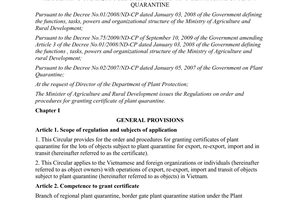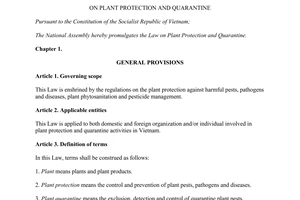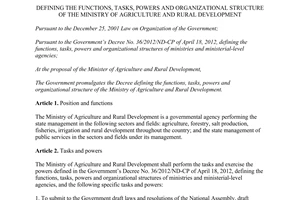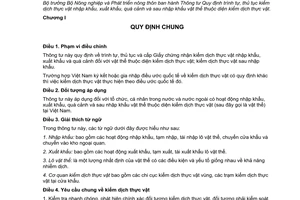Nội dung toàn văn Circular No. 33/2014/TT-BNNPTNT procedures for plant quarantine for import export transit
|
MINISTRY OF
AGRICULTURE AND RURAL DEVELOPMENT |
SOCIALIST
REPUBLIC OF VIETNAM |
|
Hanoi, October 30, 2014 |
CIRCULAR
ON PROCEDURES FOR PLANT QUARANTINE FOR IMPORT, EXPORT, TRANSIT AND POST-IMPORT OF ARTICLES SUBJECT TO PLANT QUARANTINE
Pursuant to the Law on plant Protection and Quarantine No. 41/2013/QH13;
Pursuant to the Decree No. 199/2013/NĐ-CP dated 26/11/2013 by the Government defining the functions, tasks, entitlements and organizational structure of the Ministry of Agriculture and Rural development;
At the request of the Director of Plant Protection Department;
The Minister of Agriculture and Rural development promulgates the Circular on procedures for the plant quarantine for import, export, transit and post-import of articles subject to plant quarantine.
Chapter I
GENERAL PROVISIONS
Article 1. Scope of regulation
This Circular provides the procedures for the issuance of Phytosanitary Certificate for import/export/transit with regard to articles subject to plant quarantine and procedures for post-import plant quarantine.
If Vietnam accedes an International Agreement on plant quarantine whose regulation is different from this Circular, such International Agreement shall prevail.
Article 2. Regulated entities
This Circular applies to Vietnamese and foreign organizations and individuals that engage in import, export, transit or post-import activities that involves articles subject to plant quarantine (hereinafter referred to as articles) in Vietnam.
Article 3. Interpretation of terms
In this Circular, these terms can be construed as follows:
1. Import: an activity that a consignment of articles is imported, temporarily imported, re-imported or transported to another custom post outside the checkpoint area and to bonded warehouses.
2. Export: is an activity that a consignment of articles is exported, temporarily exported or re-exported.
3. Consignment of articles (hereinafter referred to as consignment): is a definite amount of articles having the same conditions and immunity.
4. Plant quarantine bodies are plant quarantine departments of regions, plant quarantine stations at border checkpoints.
Article 4. General requirements for plant quarantine
1. Quickly examine to identify exactly the quarantine pests, pests subject to control in Vietnam, and the alien pests that live on the articles during their import, export, transit, and after their import.
2. Promptly decide the suitable handling measures for items infected with the quarantine pests, pests subject to control in Vietnam and alien pests.
Article 5. Charges and fees
Applicants shall pay charges and fees for plant quarantine according to the regulation on charges and fees.
Chapter II
PROCEDURES FOR QUARANTINE OF IMPORTED PLANTS
Article 6. Application for quarantine of imported plants
1. An application form for plant quarantine (prescribed in Annex I enclosed herewith).
2. A copy or an original of the Phytosanitary Certificate issued by a competent plant quarantine body of the exporting country.
If the applicant submits the copy, the original must be submitted before the consignment is issued with the Phytosanitary Certificate for import, transit and inland transport.
3. An original or a certified true copy of the Phytosanitary Certificate for import (if necessary).
Article 7. Procedure for quarantine of imported plants
1. Application for plant quarantine
The applicant shall submit directly 01 application for quarantine of imported plants to a plant quarantine body.
2. Receipt and examination of application
Plant quarantine bodies are responsible for receiving and examining the conformity of the application according to the regulation. If the application is not satisfactory, the quarantine body shall request the applicant to complete the application;
3. Examination on the articles
Based on the result of the examination of the application, the plant quarantine body shall decide the location and appoint officials to examine the consignment in the following order:
a) Preliminary examination
The examining officials shall examine the outside of the consignment, the package, means of conveyance; examine chinks and crevices where pests may hide; collect the insects that move around or stick on the consignment.
b) Detailed examination
The examining officials shall examine the inside of the consignment and collect samples according to QCVN 01-141:2013/BNNPTNT National technical regulation on methods of sampling; collect the articles presenting the symptoms of disease and pests; analyze the collected samples and pests.
4. Issuance of Phytosanitary Certificate
a) If the consignment is considered to be free from the quarantine pests, pests subject to control in Vietnam or alien pests, plant quarantine bodies shall issue the Phytosanitary Certificate for import, transit and inland transport (according to Annex II enclosed herewith) within 24 hours from the beginning of the quarantine.
If the issuance duration exceeds 24 hours due to the technical requirements or if the application for Phytosanitary Certificate is rejected, the quarantine body shall notify the applicant or make a written response providing the explanation.
b) If the consignment is found infected with quarantine pests, pests subject to control in Vietnam or alien pests, the plant quarantine body shall decide the suitable handling measures according to the regulation.
c) If the consignment is transported by vessels whose hold is ≥ 3m in height and must be divided into parts for examining, then after examining each part, based on the result, the plant quarantine body shall issue the Temporary Phytosanitary Certificate to the amount of articles that have been examined (according to the form in Annex III enclosed herewith)
After receiving the Temporary Phytosanitary Certificate, the consignment may be put into storage and shall be used for manufacture or trading only when the Phytosanitary Certificate for import, transit and inland transport is issued. Based on the result of the examination on the whole consignment, plant quarantine body shall issue the consignment with Phytosanitary Certificate for import, transit and inland transport.
Article 8. Notification of plant quarantine
1. Notification to the exporting country
Plant Protection Department shall notify a competent plant quarantine body of the exporting country of:
a) Articles that are found infected with the quarantine pests, pests subject to control in Vietnam or alien pests and plant quarantine methods to be applied.
b) Articles that have not been allowed to import into Vietnam;
c) Articles without Phytosanitary Certificate issued by competent agencies of the exporting country;
d) Articles that is unconformable to the regulations on plant quarantine of Vietnam.
2. Notification to the applicant and other relevant organizations
Plant quarantine bodies shall notify the owner or other relevant offices of:
a) The cases prescribed in clause 1 of this Article;
b) The consignments containing plant varieties or beneficial organisms.
Chapter III
PROCEDURES FOR QUARANTINE OF EXPORTED PLANTS
Article 9. Application for quarantine of exported plants
1. An application form for quarantine of exported or re-exported plants (using the form in Annex IV enclosed herewith).
2. The original of the Phytosanitary Certificate of the exporting country (with regard to the re-export).
Article 10. Procedures for quarantine of exported plants
1. Application for plant quarantine
The applicant shall submit directly 01 application to the nearest plant quarantine body.
2. Receipt and examination of the application
Plant quarantine bodies are responsible for receiving and examining the conformity of the application according to the regulation in clause 2 Article 7 of this Circular.
3. Examination on the articles
Based on the examination on the application, the plant quarantine body decide the place for quarantine at the manufacturer, the export place, the inland storage place or checkpoint of export and promptly appoint officials to examine the consignment.
The examination on the consignment is performed according to the regulation in clause 3 Article 7 of this Circular.
4. Issuance of Phytosanitary certificate
a) If the consignment satisfies the plant quarantine requirements of the importing countries, the plant quarantine body shall issue such consignment with the Phytosanitary Certificate (using the form in Annex V enclosed herewith) or the Phytosanitary Certificate for re-export (using the form in Annex VI enclosed herewith) within 24 hours from the beginning of quarantine.
If the issuance duration exceeds 24 hours due to the technical requirements, the quarantine body shall notify the applicant or make a written response providing the explanation.
b) If the consignment is considered unconformable with the plant quarantine requirements of the importing countries, the plant quarantine body shall refuse to issue the Phytosanitary Certificate and notify the applicant.
Chapter IV
PROCEDURES FOR QUARANTINE OF PLANTS IN TRANSIT
Article 11. Application for quarantine of plants in transit:
1. An application form for plant quarantine (using the form in Annex I enclosed herewith).
2. A copy or an original of the Phytosanitary Certificate issued by the exporting country.
If the applicant submits the copy, the original must be submitted before the consignment is issued with the Phytosanitary Certificate for import, transit and inland transport.
3. An original or a certified true copy of the Phytosanitary Certificate for import.
Article 12. Procedures for quarantine of plants in transit
1. Application for plant quarantine
The applicant shall submit directly 01 application for quarantine of plants in transit to a plant quarantine body.
2. Receipt and examination of the application
Plant quarantine bodies are responsible for receiving and examining the conformity of the application according to the regulation in clause 2 Article 7 of this Circular.
3. Examination on the articles
Based on the result of the examination on the application, the plant quarantine body shall decide the location and appoint officials to examine the consignment in the following order:
a) Preliminary examination
The examining official shall examine the outside of the consignment, the packages, means of conveyance; examine the chinks and crevices where pests may hide; collect the insects that move around or stick on the consignment.
b) Detailed examination
The examining official shall examine the status of package and the consignment; analyze the collected sample of articles, pests.
If the package condition is not satisfactory, the applicant must repack the consignment.
4. Issuance of Phytosanitary certificate
a) If the consignment satisfies the requirement of plant quarantine of the importing countries, plant quarantine bodies shall issue such consignment with the Phytosanitary Certificate for export, transits and inland transport within 24 hours from the beginning of the quarantine.
b) If the consignment contains articles that are found infected with quarantine pests, pests subject to control in Vietnam or alien pests, plant quarantine shall decide the suitable handling measures in accordance with the regulation.
Chương V
POST-IMPORT QUARANTINE
Article 13. Articles subject to post-import quarantine:
1. Budwood, cultivar, graft and rootstock that are compelled to undergo plant quarantine for post-import according to pest risk analysis results.
2. Beneficial organisms
Article 14. Amount of items subject to post-import quarantine
1. Budwood; bud, cultivar: 30-50 items.
2. Graft, rootstock: 10-20 items.
3. Beneficial organisms: specified in pest risk analysis report.
Article 15. Contents of post-import quarantine
1. With regard to plant varieties:
Latent pests specified in pest risk analysis report shall be inspected.
2. With regard to beneficial organisms:
The purity, the adaptability to a particularly host of organisms in isolation areas serving multiplication shall be examined. With regard to beneficial insects and spiders, the criteria of level 2 parasitism shall be examined.
Article 16. Procedures for post-import quarantine in isolation area.
1. Preliminary examination
The general condition of the consignment shall be examined; the relevant information shall be noted.
2. Examination on the consignment
a) With regard to plant varieties:
All of articles that are grown in the isolation area serving plant quarantine shall be examined. The isolation area must be conformable to the National technical regulation of the Ministry of Agriculture and Rural Development;
The caring methods appropriate to different varieties of plant must be applied to ensure their development and pests must be facilitated the best condition so that they can quickly display the symptoms;
All the planted trees must be examined both regularly and irregularly;
Samples of trees that perform unusual signal, samples of pests and information on the symptoms must be collected for the assessment of pathogens.
b) With regard to beneficial organisms
All the individuals must be examined to evaluate the purity;
The adaptability to a particular host must be examined and identified;
With regard to beneficial insects, spiders: the condition of the consignment shall be regularly examined and monitored, the dead individuals shall be collected for Level 2 parasitism test.
3. The result of post-import quarantine
After the monitoring period, the agency in charge of post-import quarantine shall report to Plant Protection Department for consideration and decision.
Article 17. Duration of supervision
Duration of examination and supervision of post-import quarantine is specified for different types of plant varieties and beneficial organisms as follows:
1. Bud, budwood, graft, rootstock: 1-2 years.
2. Cultivar (tree): 6-12 months.
3. Cultivar (bulb): 1 life cycle.
4. Beneficial organisms: at least 1 generation
Chapter VI
IMPLEMENTATION
Article 18. Responsibilities of plant Protection Department
1. Provide guidance and monitor the implementation of plant quarantine bodies.
2. Notify the exporting country in the cases prescribed in clause 1 Article 8 of this Circular.
3. Propagate the regulation in this Circular to relevant organizations and individuals.
Article 19. Responsibilities of Plant quarantine bodies
1. Receive, examine the application, examine the consignment, issue the Phytosanitary Certificate and perform other plant quarantine activities as prescribed in this Circular.
2. Store, transfer, transport and destroy the samples of infected articles or samples of pests; draw up and store the dossiers on plant quarantine according to current regulations.
Article 20. Effect
This Circular takes effect on January 01, 2015.
This Circular replaces the Circular No. 65/2012/TT-BNNPTNT dated 26/12/2012 by the Minister of Agriculture and Rural development on procedures for the issuance of Phytosanitary Certificate. Forms No. 3, 7, 8, 9, 10, 11 of Annex I enclosed with Circular No. 14/2012/TT-BNNPTNT dated 27/03/2012 by the Ministry of Agriculture and Rural development providing guidance on plant quarantine documents are annulled.
Article 21. Organization of implementation
Director of Plant Protection Department, Heads of relevant offices/organizations and individuals are responsible for the implementation of this Circular.
Difficulties that arise during the implementation of this Circular should be reported to the Ministry of Agriculture and Rural development or Plant Protection Department for consideration and resolution./.
|
|
PP. THE
MINISTER |
------------------------------------------------------------------------------------------------------
This translation is made by LawSoft and
for reference purposes only. Its copyright is owned by LawSoft
and protected under Clause 2, Article 14 of the Law on Intellectual Property.Your comments are always welcomed



